October 2004Trading Tip:
Analysis Using Trend Lines
by Howard Arrington
The six tips illustrated this month are effective techniques for
finding winning trades and maximizing profits. Even though my
illustrations make it look easy, the process of analyzing charts and
trading is still hard work. Also, I have the benefit of
hindsight in selecting a good example to use to illustrate these
tips.
The Power of Trend Lines
I am frequently asked which is the best study or tool to use to
trade the markets. I think the best analytical tool is drawing
a straight line on a chart beneath the lows of bars to show a rising
trend, and above the highs of bars to show a falling trend. A
tool this simple does not require a computer. Yet, because
traders have computers, they overlook the power of a trend line, and
number crunch massive quantities of data through complex formulas
searching for a secret methodology no one has discovered.
Forget it. I have been there and done that. I keep
coming back to the simplicity of manually drawing trend lines on a
chart. When the chart trend reverses and breaks through the
trend line, a new position is taken. This is the primary tool
I use, and everything else you learn is just an enhancement to the
power of the trend line.
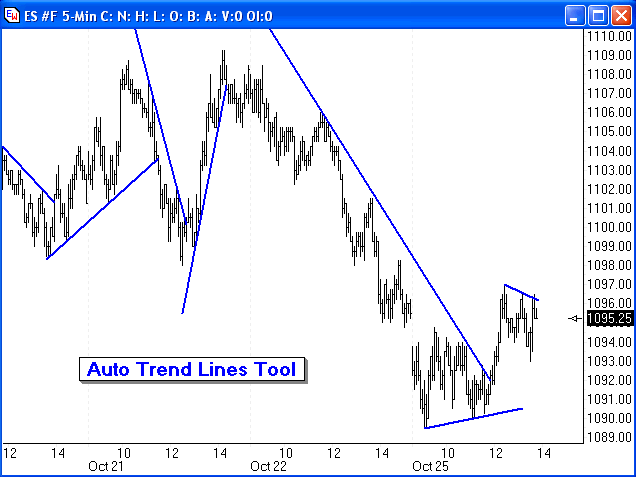
Ensign
Windows has a very powerful and unique tool called Auto Trends,
which is illustrated on the chart above. The trend lines
are calculated and drawn automatically by the software, in
real-time. The tool has proven to be very helpful and
greatly appreciated by many day traders. The Auto Trends
tool has several options that increase its value. These
options can be seen on the property window for the tool.
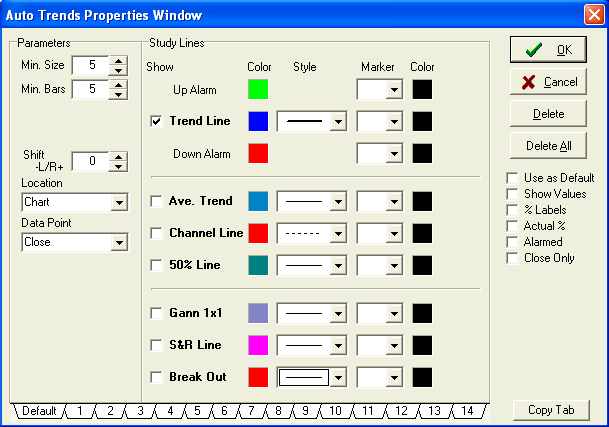
An Alarmed trend line will display an alert message
box in green when price action breaks upward through a descending
trend line, and display an alert message box in red when prices
break below the ascending trend line.
Average Trend uses the principle of Parallelism in
trends, and suggests the next trend based on the average slopes of
prior trend lines. This feature is illustrated in
the next chart.

The red trend lines are the average trend lines and
show the typical slope seen in earlier trends.
Channel Lines and 50% Lines (mid-channel) can be added
by checking the boxes for those options.
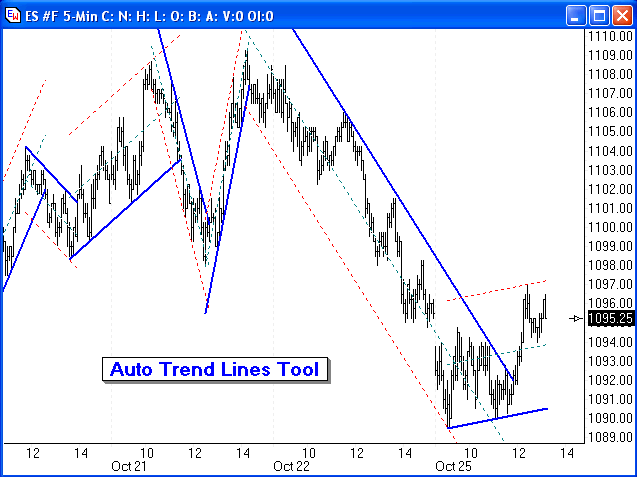
The Gann 1x1 option will automatically place the 1x1
line on the chart from the swing points. This is similar to
placing a Gann fan on the chart to show the 1x1 line.
The slope for the Gann 1x1 line is determined by the proprietary
technique Ensign Windows uses to square price and time.
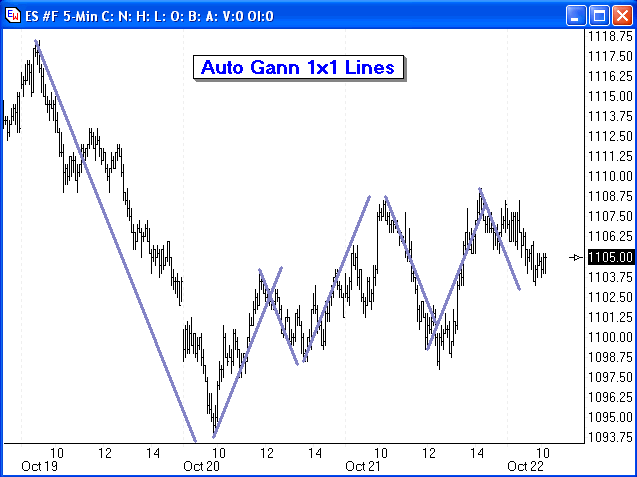
The last two options for the Auto Trends tool can be
used to show Support and Resistance and Break Out trend lines, as
illustrated in this chart.
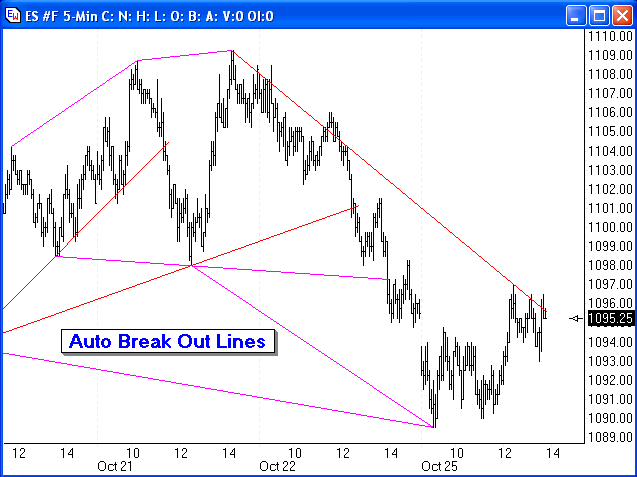
The Power of Parallel Lines
The first analysis principle is that prices move in trends, but
the trends do not last forever. Eventually price movement
changes direction and breaks through the trend line. The
second principle I use is observing that up trend lines are
frequently parallel to each other. This means there is a
repeatable chart characteristic in the rate at which price movement
advances. Likewise, down trend lines are frequently parallel
to each other. I use this principle of parallel lines to give
me an idea of what would be a typical up trend or typical down trend
when price movement changes direction, and a new trend starts.
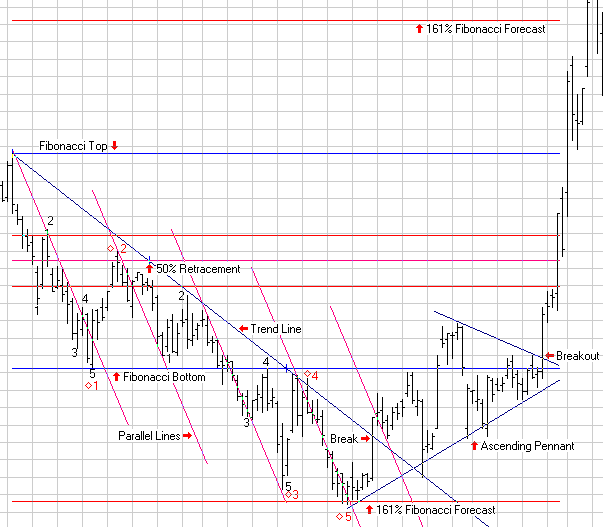
The Power of Pennants
Pennant formations indicate the balancing of opposing market
forces. The pennant is a narrowing triangle where prices are
making subsequent lower-highs and higher-lows. Prices usually
break out of a pennant pattern rapidly with the frequent presence of
a gap, increased bar range and increased volume. Join the move
in the direction of the break-out. Odds favor a breakout to the
upside from an ascending pennant, and to the downside from a
descending pennant. A smaller variation to a pennant is a flag
where price movement pauses and moves sideways after a steep
move. Odds favor a break away from the flag to resume in the
same direction.
The Power of Fibonacci Price Levels
Fibonacci price levels are constructed by drawing horizontal
lines at the top and bottom of a recent trend. The band is
then sub-divided with additional horizontal lines at significant
percentages. The three retracement sub-division percentages I
use the most are 38.2 percent, 50 percent, and 61.8 percent.
These percentages are members of a set of Fibonacci Price
levels. When a trend is being used to forecast the size of a
subsequent larger trend, the significant percentage I use is 161.8
percent.
Prices often extend or retrace to these Fibonacci price levels,
and then reverse direction. Confidence is increased that a
trend has fulfilled itself when its slope is parallel to other
trends, the number of bars in the trend is a Fibonacci count, and
the price is near a Fibonacci price level. Fibonacci Price
Levels are easily constructed on an Ensign Windows' chart using the
trend top and bottom I select.
Another principle of horizontal lines is that previous resistance
becomes future support, and past support becomes future
resistance. Always consider significant support and resistance
levels from the past and extend horizontal lines at these levels
into the future. Note in the example that the pennant point
consolidated on the horizontal line I labeled as Fibonacci Bottom
for the first 5 wave down trend. Also, this horizontal line
was resistance to a couple of the wave tops I labeled with 4 and
diamond 4.
The Power of Counting Waves
Underlying forces cause markets to move work in ways that create
identifiable patterns, or a series of waves. Big trends are
called impulse waves, and each impulse is followed by a correction
wave. The theory named after Ralph Nelson Elliott, is
basically expressed that there will be 5 waves in the main trend,
followed by 3 waves in the corrective reaction.
I keep it simple. I look for trends with 5 waves, and corrections
with 3 waves. If I see the pattern, my confidence is increased
that the current price movement is due for a reversal. I also
look at longer term daily, weekly and monthly charts to consider the
direction of the security in its bigger picture. Trade with
the trend and use corrections as opportunities to join the direction
of the main trend.
The Power of Counting Bars
Over and over again, I am amazed at the repetition when I count
the number of bars in a trend. The count frequently is one of
the following numbers: 3, 5, 8, 13, 21, 34, or 55. These
numbers are members of a set of numbers called the Fibonacci number
sequence. Take any chart and use a straight edge to mark the
trends. Count the number of bars in each trend and label the
trend line with the bar count. Each chart will have a
characteristic that starts to appear. I have seen charts that
with regularity move up and down for either 5 or 8 or 13 bars, and
then reverse direction. This tip can be used to develop
patience, and know with greater accuracy on which bar the
trend top or bottom will be put in place. For example, there
are 8 bars in the trend from the point labeled diamond 4 to point
diamond 5.
I hope you enjoyed this review of 6 simple yet effective tools to
use in analyzing your charts. Keep it simple, and stay on the
right side by trading with the trend.
Education:
Stock Option Model - October
by Howard Arrington
This is the October update of the paper trading model based on
Bill Hatch's July article Straddle-Strangle-Swap. The
model is selling near term options in Dell Computers (DELL), Home
Depot (HD), Office Depot (OPD), and Disney (DIS), and holding
longer term options as an insurance policy. The plan is
to execute a calendar roll-out each month by buying back the short
options on the day before expiration, and selling short options one
month out. The roll-out of replacing the October options
with November options was carried out on Thursday, October 14th,
2004. The November roll-out will be carried out on Thursday,
November 18th. This is where the model stands.

DELL continued to trend upward in October which hurt
HDJG.X. Also, Disney decided to trend upward away from
$22.50 and that contributed to a loss for the month in
Disney. Since DELL and HD had strangle legs expiring in
October, those two symbols will be closed out and the model will
continue with just ODP and DIS for the balance of 2004.
The $22.50 strike in DIS which lost $1425 in October
will be resold in the November option. There is a good chance
that DIS will return to a more average range price, which would
recoup the October DISJX.X loss.
Summary:
-
Dell: - 375 - 425 + 175 + 775 +
825 + 425 = $1400 net gain, position
closed
-
HD: +1375 - 475 - 2025 + 225
- 625 + 75 = -$1450 net loss, position closed
-
ODP: - 625 - 175 + 1175 - 175 + 425 -
75 = $ 550 net gain
-
DIS: +525 - 525 - 25 + 525 - 1425
+ 325 = -$ 600 net loss
DELL and ODP basically traded sideways and produced a
profit for the model. HD and DIS trended upward and
produced losses, which is unfortunate yet something that
happens. The model is fulfilling its educational objective by
illustrating both the reward and the risk.
Education:
Stock Option Model -
Update
by Bill Hatch
Here are the net trades for the options I traded last
month....
Home Depot: I did some evaluating of
the HDJG.X and selling a calendar spread would not bring me more
than $0.50, so I sold a "diagonal". I bought back my HDJE.X
and sold my November $37.50 Call (HDKU.X). My net cost on this
was $1.80. That was less than it would have been to sell a
November call and settling up for the $2.50 next month. I was
in this position long enough before your time trial that it did not
cost me anything, but I did not make the money I expected to
make. I will not
trade HD again unless I see some reliable
variability and start trading calls and puts in expectation
of
directional movement.
Dell Computer: I bought back the October $35.00
Calls and sold November $35.00 Calls
(DLQJG.X and DLQKG.X
respectively) for $0.95. Similarly, I bought back my October
35.00 Puts and sold the November Put (DLQVG.X and DLQWG.X
respectively) for $0.90. That gives a net of +$1.85 to roll
the straddle over one month.
Office Depot: The $15 Calls (ODPJC.X and ODPKC.X)
sold for $0.50. The $15 Puts (ODPVC.X and ODPWC.X) sold for
$0.70 for a net $1.25 to roll into next month.
I netted $1.70
rolling MOT (Motorola, Inc.), and $1.20 rolling DIS (Walt Disney
Co.). My personal profits on these are marred by the Home
Depot. The others have all returned a good profit.
|